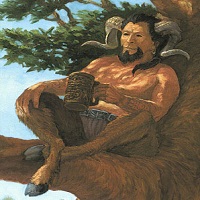
Satyr
CBUB Wins: 0
CBUB Losses: 0
CBUB Ties: 0
Win Percentage: 0%
Added by: Boratz
Read more about Satyr at: Wikipedia
Official Site: Public Domains
In Greek mythology, a satyr ( , , Greek σάτυρος saturos) is one of a troop of male companions of Pan and Dionysus. He has goat-like features. Roman Mythology identifies the Greek satyr with its faun being half-man, half-goat. "Satyress" were a late invention of poets — that roamed the woods and mountains. In myths they are often associated with pipe-playing.
The satyrs' chief was Silenus, a minor deity associated (like Hermes and Priapus) with fertility. These characters can be found in the only complete remaining satyr play, Cyclops, by Euripides, and the fragments of Sophocles' Ichneutae (Tracking Satyrs). The satyr play was a short, lighthearted tailpiece performed after each trilogy of tragedies in Athenian festivals honoring Dionysus. There is not enough evidence to determine whether the satyr play regularly drew on the same myths as those dramatized in the tragedies that preceded. The groundbreaking tragic playwright Aeschylus is said to have been especially loved for his satyr plays, but none of them have survived.
Satyrs acquired their goat-like aspect through later Roman conflation with Faunus, a carefree Italic nature spirit of similar characteristics and identified with the Greek god Pan. Hence satyrs are most commonly described in Latin literature as having the upper half of a man and the lower half of a goat, with a goat's tail in place of the Greek tradition of horse-tailed satyrs; therefore, satyrs became nearly identical with faun. Mature satyrs are often depicted in Roman art with goat's horns, while juveniles are often shown with bony nubs on their foreheads.
About Satyrs, Praxiteles gives a new interpretation on the subject of free and carefree life. Instead of an elf with pointed ears and repulsive goat hooves, we face a child of nature, pure, but tame and fearless and brutal instincts necessary to enable it to defend itself against threats, and survives even without the help of modern civilization . Above all though, the Satyr with flute has a small companion for him, shows the deep connection with nature, the soft whistle of the wind, the sound of gurgling water of the crystal spring, the birds singing, or perhaps the singing a melody of a human soul that feeds higher feelings.
CBUB Match Record:
No Regular Play Records Available
No Fantasy Draft Records Available
